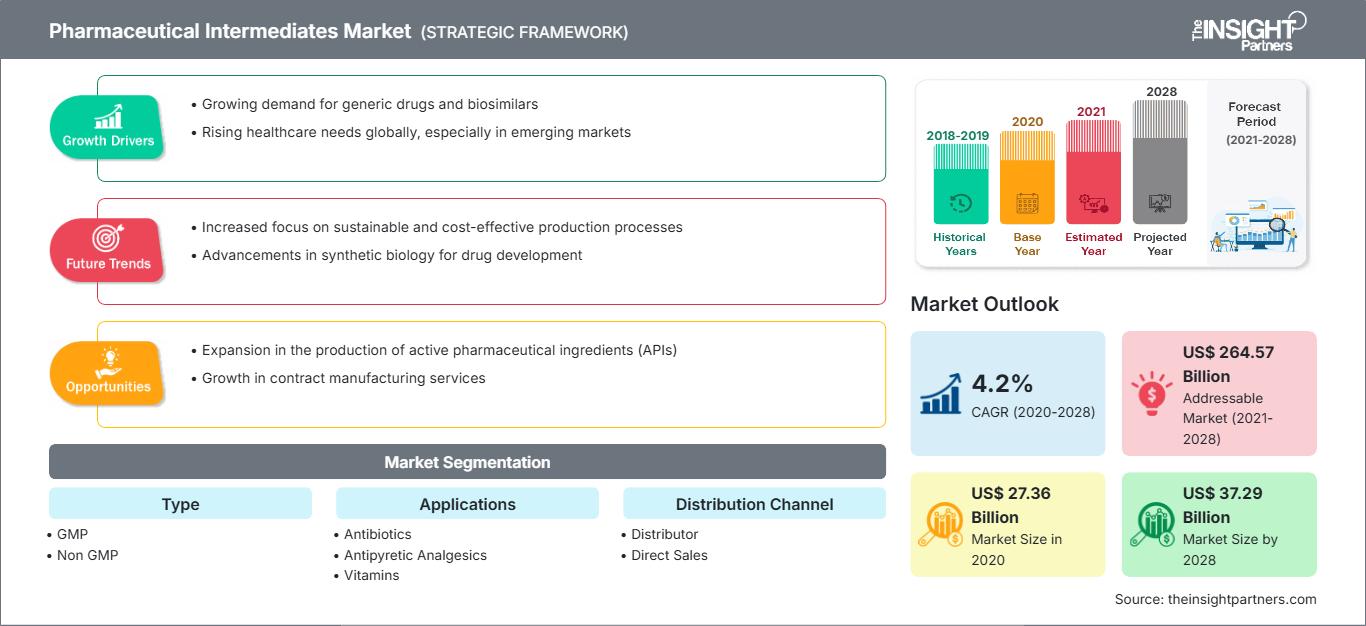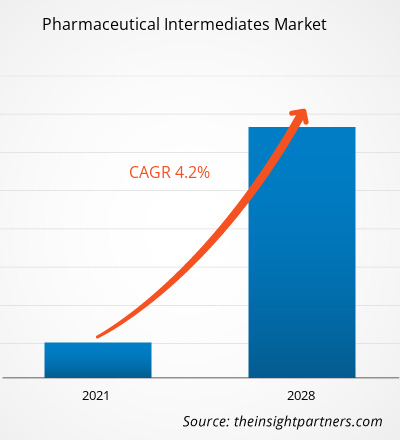Le marché des intermédiaires pharmaceutiques devrait atteindre 37 290,33 millions de dollars US en 2028, contre 27 356,70 millions de dollars US en 2020. La croissance du marché est estimée à un TCAC de 4,2 % entre 2021 et 2028.
Le marché des intermédiaires pharmaceutiques a été analysé par type, application, canal de distribution et région. Il est segmenté en Amérique du Nord, Europe, Asie-Pacifique, Moyen-Orient et Afrique, et Amérique du Sud et centrale. Le rapport met l'accent sur des paramètres tels que les tendances du marché, les avancées technologiques, la dynamique du marché et l'analyse du paysage concurrentiel des entreprises leaders afin d'offrir des perspectives et une analyse approfondie du marché des intermédiaires pharmaceutiques. Il comprend également une analyse de la pandémie de COVID-19 sur le marché dans toutes les régions clés.
Personnalisez ce rapport en fonction de vos besoins
Vous bénéficierez d’une personnalisation sur n’importe quel rapport - gratuitement - y compris des parties de ce rapport, ou une analyse au niveau du pays, un pack de données Excel, ainsi que de profiter d’offres exceptionnelles et de réductions pour les start-ups et les universités
Marché des intermédiaires pharmaceutiques: Perspectives stratégiques

-
Obtenez les principales tendances clés du marché de ce rapport.Cet échantillon GRATUIT comprendra une analyse de données, allant des tendances du marché aux estimations et prévisions.
Les intermédiaires pharmaceutiques sont les éléments constitutifs des principes actifs pharmaceutiques (API). Il s'agit de matières premières qui subissent des modifications moléculaires ou un traitement lors de la production de médicaments en vrac. Par conséquent, le besoin en intermédiaires pharmaceutiques augmente avec la hausse de la demande de médicaments pour traiter les maladies chroniques. Selon les Centres pour le contrôle et la prévention des maladies (CDC), 6 adultes sur 10 aux États-Unis souffrent d'au moins une maladie chronique, comme le cancer, les maladies cardiaques, les maladies pulmonaires, les accidents vasculaires cérébraux, les maladies neurologiques, le diabète et les maladies rénales. De plus, 4 adultes sur 10 dans le pays souffrent de deux maladies chroniques ou plus. De plus, selon le communiqué de presse de l'Alliance européenne pour les maladies chroniques (ECDA), en 2014, 9 personnes sur 10 en Europe décèdent des suites de maladies chroniques. Ainsi, 70 à 80 % des coûts totaux des soins de santé sont consacrés à la gestion des maladies chroniques.
La prévalence croissante des maladies infectieuses, notamment en Asie du Sud-Est, devrait également stimuler la demande d'API dans les années à venir, stimulant ainsi la croissance du marché des intermédiaires pharmaceutiques. Par exemple, selon le rapport révisé du Programme national de lutte contre la tuberculose, environ 4,4 lakh patients sont décédés des suites de la tuberculose en Inde en 2018, soit 29 % des 1,5 million de décès causés par cette maladie dans le monde. Ainsi, cette prévalence élevée des maladies chroniques et infectieuses stimule la demande de médicaments, soulignant à terme le besoin d'intermédiaires pharmaceutiques.
Informations par type
Le marché des intermédiaires pharmaceutiques, par type, est segmenté en BPF et non BPF. Français Le segment GMP détenait la plus grande part du marché en 2020, tandis que ce même segment devrait enregistrer le TCAC le plus élevé de 4,4 % sur le marché au cours de la période de prévision.
Informations basées sur les applications
Le marché des intermédiaires pharmaceutiques, par application, est segmenté en antibiotiques, analgésiques antipyrétiques, vitamines et autres. Le segment des antibiotiques détenait la plus grande part du marché en 2020, et ce segment devrait également enregistrer le TCAC le plus élevé de 4,9 % sur le marché au cours de la période de prévision.
Informations basées sur les canaux de distribution
Sur la base du canal de distribution, le marché des intermédiaires pharmaceutiques a été segmenté en distributeur et vente directe. Le segment des ventes directes détenait la plus grande part du marché en 2020, et le segment des distributeurs devrait enregistrer le TCAC le plus élevé de 4,2 % sur le marché au cours de la période de prévision.
Les entreprises opérant sur le marché des intermédiaires pharmaceutiques adoptent des stratégies organiques telles que le lancement et l'expansion de produits pour étendre leur empreinte et leur portefeuille de produits dans le monde entier ainsi que pour répondre à la demande croissante.
Aperçu régional du marché des intermédiaires pharmaceutiques
Les tendances régionales et les facteurs influençant le marché des intermédiaires pharmaceutiques tout au long de la période de prévision ont été analysés en détail par les analystes de The Insight Partners. Cette section aborde également les segments et la géographie du marché des intermédiaires pharmaceutiques en Amérique du Nord, en Europe, en Asie-Pacifique, au Moyen-Orient et en Afrique, ainsi qu'en Amérique du Sud et en Amérique centrale.
Portée du rapport sur le marché des intermédiaires pharmaceutiques
| Attribut de rapport | Détails |
|---|---|
| Taille du marché en 2020 | US$ 27.36 Billion |
| Taille du marché par 2028 | US$ 37.29 Billion |
| TCAC mondial (2020 - 2028) | 4.2% |
| Données historiques | 2018-2019 |
| Période de prévision | 2021-2028 |
| Segments couverts |
By Type
|
| Régions et pays couverts |
Amérique du Nord
|
| Leaders du marché et profils d'entreprises clés |
|
Densité des acteurs du marché des intermédiaires pharmaceutiques : comprendre son impact sur la dynamique des entreprises
Le marché des intermédiaires pharmaceutiques connaît une croissance rapide, portée par une demande croissante des utilisateurs finaux, due à des facteurs tels que l'évolution des préférences des consommateurs, les avancées technologiques et une meilleure connaissance des avantages du produit. Face à cette demande croissante, les entreprises élargissent leur offre, innovent pour répondre aux besoins des consommateurs et capitalisent sur les nouvelles tendances, ce qui alimente la croissance du marché.

- Obtenez le Marché des intermédiaires pharmaceutiques Aperçu des principaux acteurs clés
- Analyse historique (2 ans), année de base, prévision (7 ans) avec TCAC
- Analyse PEST et SWOT
- Taille du marché Valeur / Volume - Mondial, Régional, Pays
- Industrie et paysage concurrentiel
- Ensemble de données Excel
Rapports récents
Rapports connexes
Témoignages
Raison d'acheter
- Prise de décision éclairée
- Compréhension de la dynamique du marché
- Analyse concurrentielle
- Connaissances clients
- Prévisions de marché
- Atténuation des risques
- Planification stratégique
- Justification des investissements
- Identification des marchés émergents
- Amélioration des stratégies marketing
- Amélioration de l'efficacité opérationnelle
- Alignement sur les tendances réglementaires






















 Obtenez un échantillon gratuit pour - Marché des intermédiaires pharmaceutiques
Obtenez un échantillon gratuit pour - Marché des intermédiaires pharmaceutiques